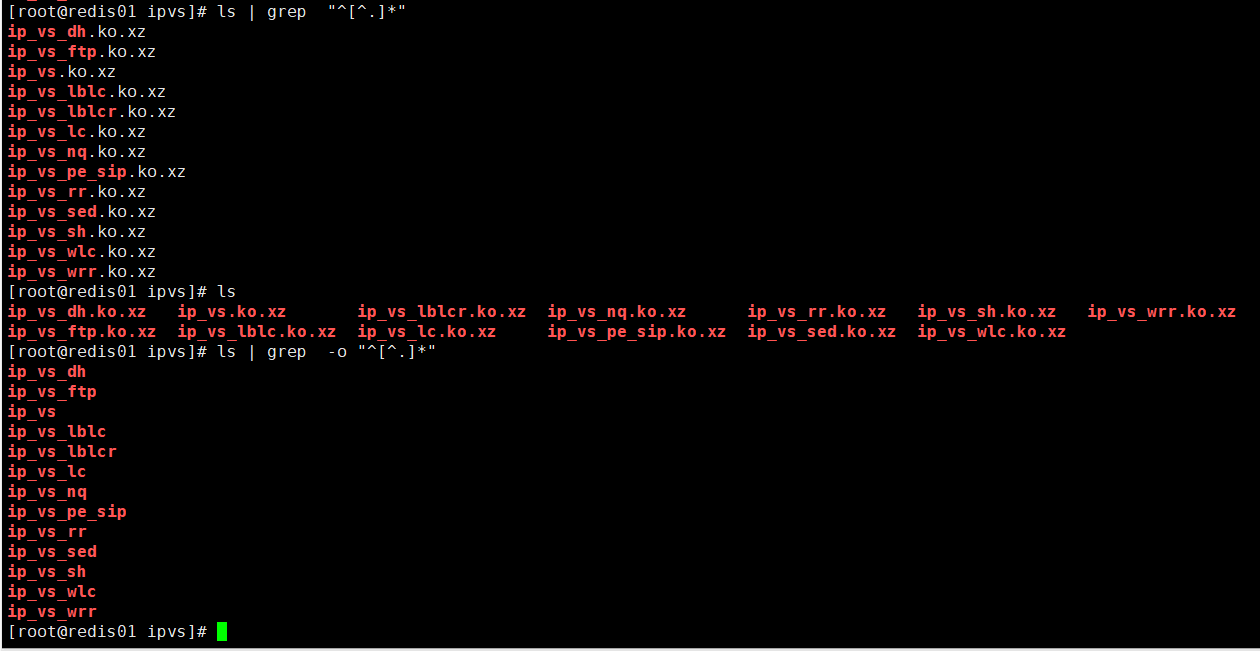1、
实例9:输出非u开头的行内容,是匹配到u截止
命令:
cat test.txt |grep ^[^u]
这个-o参数,是指输出匹配到的内容,
ls | grep -o "^[^.]*"

5.使用实例:
说明:
实例3:从文件中读取关键词进行搜索
命令:
cat test.txt | grep -f test2.txt
输出:
[root@localhost test]# cat test.txt
hnlinux
peida.cnblogs.com
ubuntu
ubuntu linux
redhat
Redhat
linuxmint
[root@localhost test]# cat test2.txt
linux
Redhat
[root@localhost test]# cat test.txt | grep -f test2.txt
hnlinux
ubuntu linux
Redhat
linuxmint
[root@localhost test]#
说明:
输出test.txt文件中含有从test2.txt文件中读取出的关键词的内容行
实例3:从文件中读取关键词进行搜索 且显示行号
命令:
cat test.txt | grep -nf test2.txt
输出:
[root@localhost test]# cat test.txt
hnlinux
peida.cnblogs.com
ubuntu
ubuntu linux
redhat
Redhat
linuxmint
[root@localhost test]# cat test2.txt
linux
Redhat
[root@localhost test]# cat test.txt | grep -nf test2.txt
1:hnlinux
4:ubuntu linux
6:Redhat
7:linuxmint
[root@localhost test]#
说明:
输出test.txt文件中含有从test2.txt文件中读取出的关键词的内容行,并显示每一行的行号
实例5:从文件中查找关键词
命令:
grep 'linux' test.txt
输出:
[root@localhost test]# grep 'linux' test.txt
hnlinux
ubuntu linux
linuxmint
[root@localhost test]# grep -n 'linux' test.txt
1:hnlinux
4:ubuntu linux
7:linuxmint
[root@localhost test]#
说明:
实例6:从多个文件中查找关键词
命令:
grep 'linux' test.txt test2.txt
输出:
[root@localhost test]# grep -n 'linux' test.txt test2.txt
test.txt:1:hnlinux
test.txt:4:ubuntu linux
test.txt:7:linuxmint
test2.txt:1:linux
[root@localhost test]# grep 'linux' test.txt test2.txt
test.txt:hnlinux
test.txt:ubuntu linux
test.txt:linuxmint
test2.txt:linux
[root@localhost test]#
说明:
多文件时,输出查询到的信息内容行时,会把文件的命名在行最前面输出并且加上":"作为标示符
实例7:grep不显示本身进程
命令:
ps aux|grep [s]sh
ps aux | grep ssh | grep -v "grep"
输出:
[root@localhost test]# ps aux|grep ssh
root 2720 0.0 0.0 62656 1212 ? Ss Nov02 0:00 /usr/sbin/sshd
root 16834 0.0 0.0 88088 3288 ? Ss 19:53 0:00 sshd: root@pts/0
root 16901 0.0 0.0 61180 764 pts/0 S+ 20:31 0:00 grep ssh
[root@localhost test]# ps aux|grep [s]sh]
[root@localhost test]# ps aux|grep [s]sh
root 2720 0.0 0.0 62656 1212 ? Ss Nov02 0:00 /usr/sbin/sshd
root 16834 0.0 0.0 88088 3288 ? Ss 19:53 0:00 sshd: root@pts/0
[root@localhost test]# ps aux | grep ssh | grep -v "grep"
root 2720 0.0 0.0 62656 1212 ? Ss Nov02 0:00 /usr/sbin/sshd
root 16834 0.0 0.0 88088 3288 ? Ss 19:53 0:00 sshd: root@pts/0
说明:
实例8:找出已u开头的行内容
命令:
cat test.txt |grep ^u
输出:
[root@localhost test]# cat test.txt |grep ^u
ubuntu
ubuntu linux
[root@localhost test]#
说明:
实例9:输出非u开头的行内容
命令:
cat test.txt |grep ^[^u]
输出:
[root@localhost test]# cat test.txt |grep ^[^u]
hnlinux
peida.cnblogs.com
redhat
Redhat
linuxmint
[root@localhost test]#
说明:
实例10:输出以hat结尾的行内容
命令:
cat test.txt |grep hat$
输出:
[root@localhost test]# cat test.txt |grep hat$
redhat
Redhat
[root@localhost test]#
说明:
实例11:输出ip地址
命令:
ifconfig eth0|grep -E "([0-9]{1,3}.){3}[0-9]"
输出:
[root@localhost test]# ifconfig eth0|grep "[0-9]{1,3}.[0-9]{1,3}.[0-9]{1,3}.[0-9]{1,3}"
inet addr:192.168.120.204 Bcast:192.168.120.255 Mask:255.255.255.0
[root@localhost test]# ifconfig eth0|grep -E "([0-9]{1,3}.){3}[0-9]"
inet addr:192.168.120.204 Bcast:192.168.120.255 Mask:255.255.255.0
[root@localhost test]#
说明:
实例12:显示包含ed或者at字符的内容行
命令:
cat test.txt |grep -E "ed|at"
输出:
[root@localhost test]# cat test.txt |grep -E "peida|com"
peida.cnblogs.com
[root@localhost test]# cat test.txt |grep -E "ed|at"
redhat
Redhat
[root@localhost test]#
说明:
实例13:显示当前目录下面以.txt 结尾的文件中的所有包含每个字符串至少有7个连续小写字符的字符串的行
命令:
grep '[a-z]{7}' *.txt
输出:
[root@localhost test]# grep '[a-z]{7}' *.txt
test.txt:hnlinux
test.txt:peida.cnblogs.com
test.txt:linuxmint
[root@localhost test]#
实例14:日志文件过大,不好查看,我们要从中查看自己想要的内容,或者得到同一类数据,比如说没有404日志信息的
命令:
grep '.' access1.log|grep -Ev '404' > access2.log
grep '.' access1.log|grep -Ev '(404|/photo/|/css/)' > access2.log
grep '.' access1.log|grep -E '404' > access2.log
输出:
[root@localhost test]# grep “.”access1.log|grep -Ev “404” > access2.log
说明:上面3句命令前面两句是在当前目录下对access1.log文件进行查找,找到那些不包含404的行,把它们放到access2.log中,后面去掉’v’,即是把有404的行放入access2.log